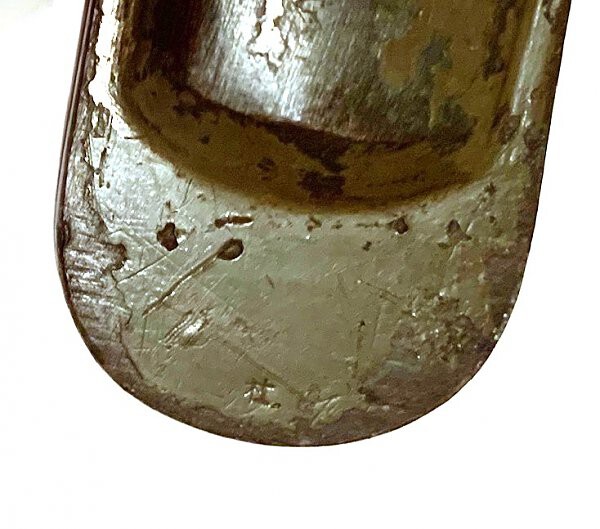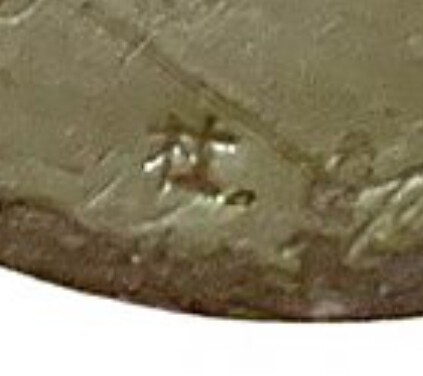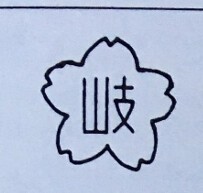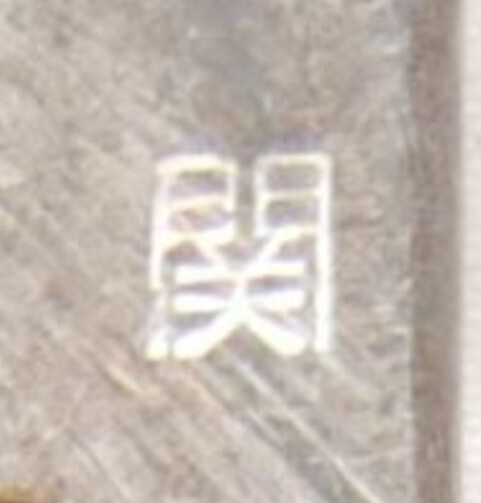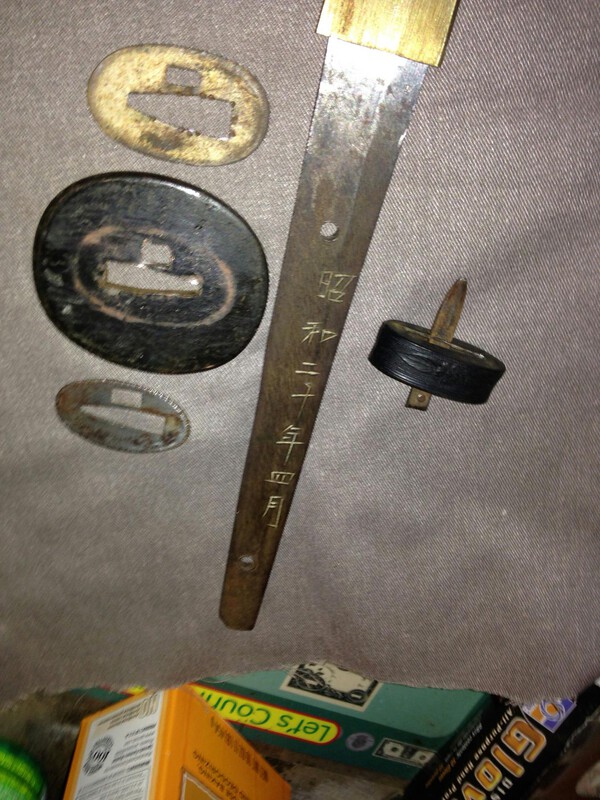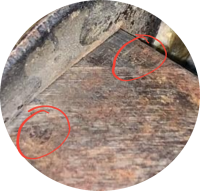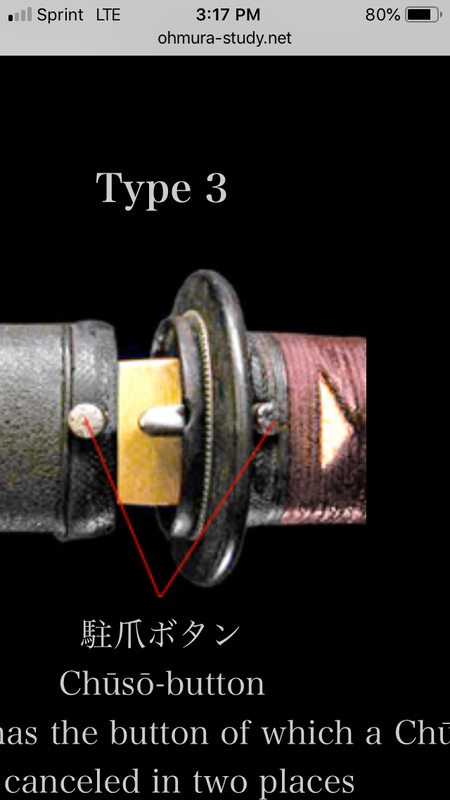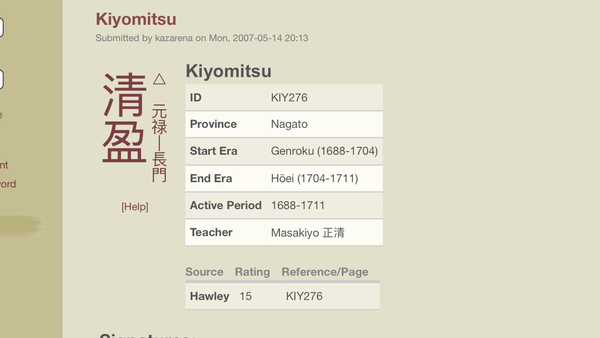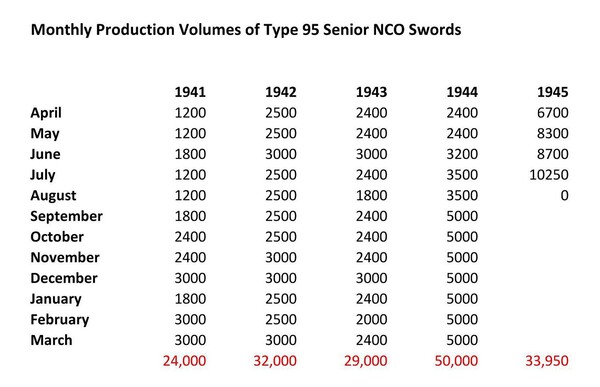-
Posts
12,987 -
Joined
-
Last visited
-
Days Won
155
Content Type
Profiles
Forums
Events
Store
Downloads
Gallery
Everything posted by Bruce Pennington
-

Col Nakagawa, Peleliu Inscription?
Bruce Pennington replied to Bruce Pennington's topic in Translation Assistance
The file marks aren’t Mantetsu standard either. -

"Sha" Stamp Significance
Bruce Pennington replied to Bruce Pennington's topic in Translation Assistance
You made me realize it would be easy to find out - the gunto was a Tokyo arsenal product (blade and fuchi Stamps). So the question is why was a Tokyo inspector using this stamp? We may never know. A possibility is that the thousands of gunto per month were too much for arsenal staff to inspect, and company inspectors were augmenting them. The 95s were made by a few contractor companies. It could mean a contractor inspector checked this one off. -

Pictures Of "tanker"
Bruce Pennington replied to Ontario_Archaeology's topic in Military Swords of Japan
Great picture Jareth. I’m pretty sure that’s a Type 95, with a leather NCO tassel, though. -
Just found a stamp I've never seen before on a Type 95 saya drag. Am told it's "Sha". Anyone know the significance? Drag stamps are usually inspector stamps from an arsenal - "To" from Tokyo, "Na" from Nagoya.
-

Col Nakagawa, Peleliu Inscription?
Bruce Pennington replied to Bruce Pennington's topic in Translation Assistance
Thanks to all for your thoughts. You have a depth of knowledge on nihonto that I will never know. John, Is his name in the action text as seller, or are you saying that this is his style of product? I'll have to go back and check if the other wavy hamon blade was a Komonjo sale. I had a brief chat online with him. He says he sells on consignment from sellers in Japan. I'm beginning to suspect that a particular seller in Japan is becoming a Mantetsu geimei professional. I will find out about the previous blade. Update: The previous '41 Wavy also came from Buyee.jp auction site, so Komonjo is not the seller, though, the same guy in Japan very well may be. I don't see a seller name on that site for blade autions. -
Classic Damascus steel
-

Attention Mantetsu Owners: A Survey
Bruce Pennington replied to Bruce Pennington's topic in Military Swords of Japan
Thanks to Ontario_Archaeology for this find on a Japanese auction site https://buyee.jp/item/yahoo/auction/w307428001/detail#googtrans(ja|en). Claims to be carried by a Col Nakagawa on Peleliu; FULL HAMON. It's the second one I've come across recently with wavy hamon, and both are Spring '41's. I've got the inscription posted over on Translation Assistance, so I'll update if significant news comes from it. As always, I welcome your thoughts. I'm aware Mantetsu made some custom blades, but these wavy hamon blades generate a bunch of suspision about gimei jobs on otherwise unsigned nihonto to drive the sell price up. -
Guys, This is on a Mantetsu blade and the Japanese auction site says the inscription is: "Kunio Nakagawa Colonel Carrying A Sword Showa Tsurami Spring" and claims it was carried by Col Nakagawa on Peleliu. Thoughts, corrections, geimei?
-

Numbers on nakago of Stsr stamped Kunitake Gendaito
Bruce Pennington replied to shibeni's topic in Military Swords of Japan
Interesting. I do recall seeing others where the number on the blade matches the numbers on the fittings. That could mean they were assembly numbers, or it could mean that the fitters simply stamped the number already on the blade to the fittings, and the blade number was originally there for other reasons. -

Numbers on nakago of Stsr stamped Kunitake Gendaito
Bruce Pennington replied to shibeni's topic in Military Swords of Japan
Bojan, I haven't studied this particular numbering system that closely. George Trotter has looked at it more deeply and says in another thread: "George, regarding "contract numbers" - does this mean each number was tied to a custom contract with an individual, or does it refer to the smith's contract with the army; and/or are the numbers representative of how many blades he's made for the army under contract? That is what we don't really know clearly Bruce. I think every customer who walked in the door and asked for a sword got a number, but maybe also the brothers just numbered each sword they produced before sending it to the polisher-mounter-retailer in Tokyo who then sold it in the Army Officer's Store on their behalf. The later type of number system may have been introduced by the RJT to identify contract makers working from their own shops in the various prefectures. "ta" may have identified Niigata Pref. and "o" may have meant Aoyama Pref. (I have a number "o"154 on a tang by Aoyama RJT Nagao Kunishiro dated 19/2). We just don't know yet." At first glance, it does seem to be tied to RJT blades, but from my vague memory, I don't think all RJT blades were numbered, though I could be wrong about that. Sounds like more study is needed on this! -

Pictures Of "tanker"
Bruce Pennington replied to Ontario_Archaeology's topic in Military Swords of Japan
Nice pic Dave! Too bad they’re all wrapped! Would be nice to see the sarute. -

Recovery of a Type 95 NCO sword
Bruce Pennington replied to zook's topic in Military Swords of Japan
Dan, don’t know how I duplicated those links, but here’s the other one I meant to post: http://www.warrelics.eu/forum/Japanese-militaria/ija-type-95-nco-sword-info-228172/ -
Agreed. Looks normal. Just be ready to do some filing to get a good fit, if necessary. It doesn't detract from the originality of the piece. These were filed and fitted to make them fit correctly on every blade produced, and damaged gunto received re-shaped tsuba/seppa in repair groups.
-

Shin-Gunto Research , what do i have?
Bruce Pennington replied to Scott M's topic in Military Swords of Japan
Ok, Scott, that baby is really stamped up, isn't it! Red - Gifu Blue - Seki (probably) Yellow - Gifu (probably) Orange - Some smiths numbered their blades, reason unknown Yellow circle - Too lightly struck to tell. -

Recovery of a Type 95 NCO sword
Bruce Pennington replied to zook's topic in Military Swords of Japan
I saw how you quietly slipped that in Steve! Do we have a rough time-frame?!?! Dan - yes, I think you're right, it's just patina. Nice example, I'm glad you've returned it to some of it's glory. -

Shin-Gunto Research , what do i have?
Bruce Pennington replied to Scott M's topic in Military Swords of Japan
I bet the overall size is pretty uniform. You’ll likely have to do a little file work in the slit for a good fit. -

Shin-Gunto Research , what do i have?
Bruce Pennington replied to Scott M's topic in Military Swords of Japan
-

Shin-Gunto Research , what do i have?
Bruce Pennington replied to Scott M's topic in Military Swords of Japan
Scott, The two are circled in the pic I'm attaching. Just a straight-on, focused picture of those, if you can. As to replacement, I would personally do it if I could find one. The small seppa (spacers either side of the larger one) look original, so all you'd need is the tsuba. Try Crimson Mist: http://www.cmmilitaryantiques.com/search.php?pcat=3, or Gunto Art Swords http://www.guntoartswords.com for starters. And I would simply email them to ask about it. They both respond quickly to emails. -

From Iwo Jima, Feb. 1945, Showato or earlier?
Bruce Pennington replied to lambo35's topic in Military Swords of Japan
Thanks Chuck! That fits nicely with the order permitting NCOs to carry privately owned swords. -

Recovery of a Type 95 NCO sword
Bruce Pennington replied to zook's topic in Military Swords of Japan
Thanks Dan! Tokyo 1st Arsenal (star), Tokyo Arsenal Inspector stamp (center one), Suya Shoten Co contractor. I'm amazed the stamps are so clear, as these fuchi with the steel plate tsuka are steel also. Can you test it with a magnet and see if it's steel or just a copper fuchi painted black? Shamsy or Stegel might correct me, but the Tokyo 1st star should put the manufacture date at or after 1941, as the Kokura arsenal (stacked cannonballs) ceased administering these after that date. -

Shin-Gunto Research , what do i have?
Bruce Pennington replied to Scott M's topic in Military Swords of Japan
Somebody correct me if wrong, but the Smith could be: 義近 (Yoshichika) Hard to say about the tsuba, without knowing more of it’s story. In my opinion it’s more likely a post-war effort to replace a missing original. The original was a flat disc: -

From Iwo Jima, Feb. 1945, Showato or earlier?
Bruce Pennington replied to lambo35's topic in Military Swords of Japan
Ray is amazing! Do you know the year or battle he captured it? NCOs were permitted to carry privately owned swords, officially, late in the war. Though we know from pictures that some carried them earlier, too. Here’s a screenshot of the smith and year timeframe from Ray’s link: -

Recovery of a Type 95 NCO sword
Bruce Pennington replied to zook's topic in Military Swords of Japan
Ha! I’ll get Nick Komiya to investage! Ha! Yes, an amazing number in that last year, and I agree, likely the poorest of the late war version. A fascinating spin off subject is the rental/purchase of NCO gunto by officers because of shortages. -

Shin-Gunto Research , what do i have?
Bruce Pennington replied to Scott M's topic in Military Swords of Japan
Scott, This model has no official designation, though most people call I t a type 44, or contingency model. Yours is dated January 19 45. It’s not really accurate to call them “late war” because they were commissioned in 1938 and started seeing production around 1941. They were designed to be a cheaper yet more hearty version of the type 98 officers sword. Someone else can give you the Smith name, as I’m not good at that. -

Recovery of a Type 95 NCO sword
Bruce Pennington replied to zook's topic in Military Swords of Japan
Dan, The topics you brushed across cover pages and pages, both in books and on our forums! A couple you'll clearly enjoy: http://www.warrelics.eu/forum/Japanese-militaria/short-development-history-type-95-gunto-676112/ and http://www.warrelics.eu/forum/Japanese-militaria/short-development-history-type-95-gunto-676112/ I don't know the metulurgy that you've already touched on with the tsukas, but a large majority of them seem to be completely devoid of paint, so you are probably onto something there. I can't swear the NCO's did it as often as officers, but it was common to wrap white cloth arount the tsukas to protect them during the war. Guys with money could outfit them in leather, and there are a couple of NCO examples of this. Here's a fascinating chart on Type 95 production found by Nick Komiya at Warrelics;



